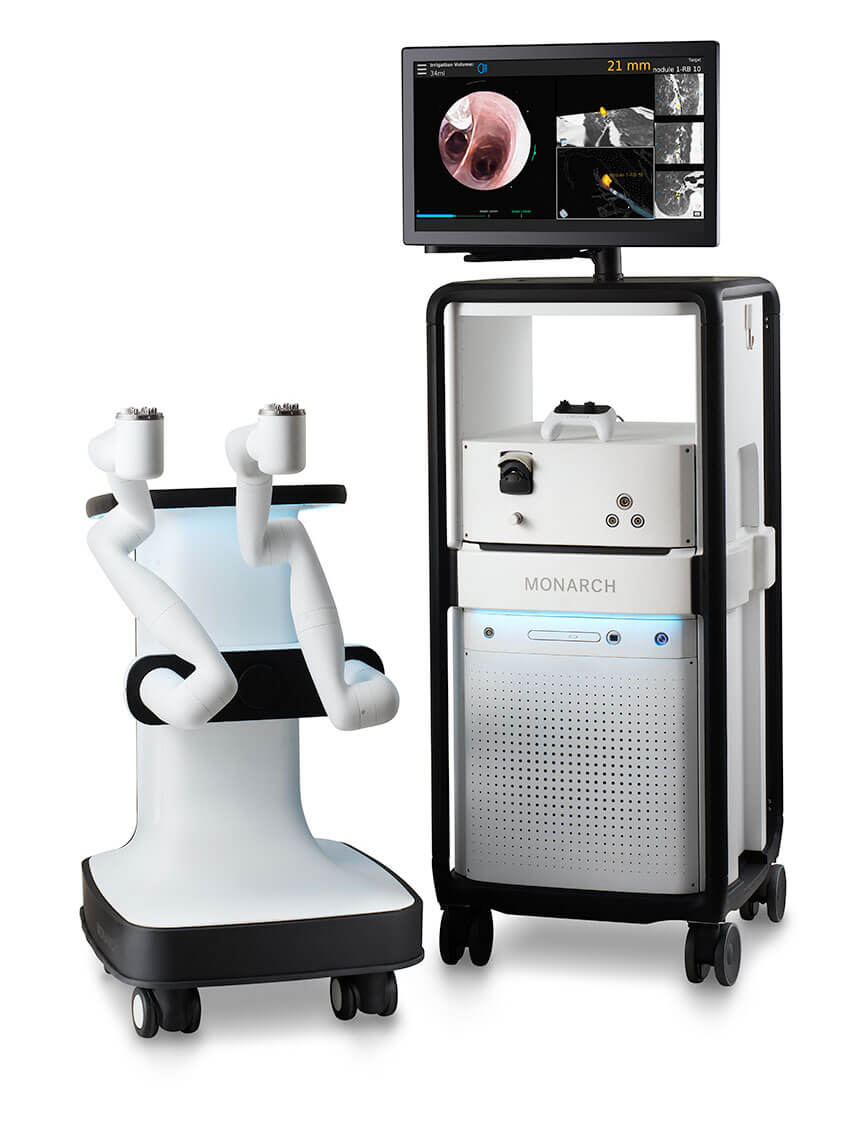University Hospitals Cleveland Medical Center Now Offers Robotic Bronchoscopy
February 14, 2021
New technology assists in diagnosing pulmonary nodules
Innovations in Pulmonary & Sleep Medicine | Winter 2021
University Hospitals is first in Northeast Ohio to acquire the Auris MonarchⓇ robotic bronchoscopy platform and will launch it in clinical practice this spring.
 Benjamin Young, MD
Benjamin Young, MD“This technology is really exciting, and a giant step forward in bronchoscope design,” says Benjamin Young, MD, Medical Director of Bronchoscopy at University Hospitals Cleveland Medical Center, and Associate Professor at Case Western Reserve University School of Medicine. “Monarch will allow us to reach smaller peripheral lung nodules that are now generally unreachable with current techniques and technology.”
Bronchoscopy is widely used in sampling pulmonary lesions, making it invaluable as a diagnostic tool. Monarch uses robot-assisted technology to further enhance the benefits of traditional bronchoscopy.
According to Dr. Young, the Monarch system uses a telescoping, scope-in-scope design. The robot controls each scope, facilitating four-way steering and precise control of movement in every direction. Using electromagnetic navigation to guide the scope, the smaller interior scope’s optics allows physicians to directly view lesions in hard-to-reach peripheral regions of the lungs, even those located just one to two centimeters from the chest wall.
 CAPTION: Auris Monarch Robotic Bronchoscopy.
CAPTION: Auris Monarch Robotic Bronchoscopy.“We can accurately locate these small, remote lesions under direct vision and biopsy them at the same time, improving the diagnostic yield significantly,” he says.
IMPROVING CLINICAL PRACTICE
Dr. Young is optimistic about the potential for earlier diagnosis and staging of malignant pulmonary nodules with robotic bronchoscopy. The results of the National Lung Screening Trial (NLST) demonstrated that annual screening of high-risk individuals with low-dose helical CT scans (LDCT) reduced their risk dying from lung cancer (versus screening with standard chest x-rays). Furthermore, the NLST and the NELSON trial found a high rate of positive screens, with roughly 80 percent of these nodules located in the periphery of the lung, which historically made them difficult to sample.
Although the guidelines are currently under review, the U.S. Preventive Services Task Force recommends annual lung cancer screening with LDCT for:
- Adults 55 to 80 who have a 30 pack-year smoking history
- Currently smoke or quit within past 15 years
- Do not have life-limiting complications
In addition to lung cancer screening, CT scans have become widely used in medical practice, resulting in a high rate of incidental findings, All told, experts expect that physicians will detect an estimated 1.6 million new pulmonary nodules each year. Knowing which nodules are benign is critical.
“With robotic bronchoscopy, we can better evaluate these incidental findings, sparing patients from further imaging or additional procedures and relieving them of unnecessary doubt and anxiety,” Dr. Young says.
“Compared to the current technology,” he adds, “robotic bronchoscopy doubles -- maybe even triples -- our ability to successfully sample these smaller and smaller lesions; those we might not even try for now.”
The U.S. Food and Drug Administration approved the Monarch system in March 2018, and clinical trials evaluating the technology are ongoing. However, preliminary trials demonstrate high yield and low rates of adverse effects.
LOOKING AHEAD
While UH Cleveland Medical Center will initially use the Monarch system to diagnose and biopsy lung nodules, Dr. Young says in the future, physicians may be able to use it for therapeutic interventions, especially for those patients who cannot undergo surgery.
“Clinical trials are underway to evaluate using robotic bronchoscopy for direct ablation of lung tumors, which may someday allow us to diagnose and treat lesions at the same time,” he says. “Although surgery will remain the gold standard for treating lung cancer, this approach may be an option for patients who are not surgical candidates. Other clinical trials are looking at using the technology to directly inject chemotherapy or immunotherapy agents into tumors. UH will likely be involved in some of these trials as we begin using the robotic bronchoscopy system.”
Because bronchoscopy has not changed much over the past several decades, Dr. Young is eager to incorporate the advanced technology into clinical practice at University Hospitals.
“Getting a good, accurate biopsy and being able to make an actual diagnosis will hopefully lead to earlier diagnosis and treatment of lung cancer, resulting in improved outcomes for patients,” he says.
For more information about lung cancer screening or robotic bronchoscopy, call Dr. Young at 216-844-3201.
https://www.ncbi.nlm.nih.gov/pmc/articles/PMC7330790/
https://www.cancer.gov/types/lung/research/nlst


